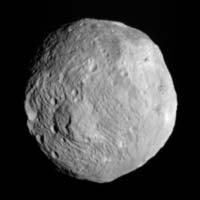
The present is the key to the past. -Sir A. Geikie
The Hubble Space Telescope observed asteroid Vesta between November 28 and December 1, 1994, when Vesta was at a distance of 251 million kilometers (156 million miles) from Earth. Vesta has a diameter of 525 kilometers (326 miles) and is smaller than the state of Arizona. It rotates about its axis in 5.34 hours.
Vesta is the most geologically diverse of the large asteroids and the only known one with distinctive light and dark areas -- much like the face of our Moon. Hubble images have revealed a diverse world with ancient lava flows and a gigantic impact basin that is so deep, it exposes the asteroid's subsurface, or mantle. Vesta's surface shows a geology similar to that of terrestrial worlds such as Earth and Mars. Ground-based spectroscopy of Vesta indicates regions that are basaltic, which means lava flows once occurred on its surface. This is surprising evidence that the asteroid once had a molten interior, like Earth does. This contradicts conventional ideas that asteroids are essentially cold, rocky fragments left behind from the early days of planetary formation.
One possibility is that Vesta agglomerated from smaller material that includes radioactive debris (such as the the isotope Aluminum-26) that was incorporated into the core. This radioactive "shrapnel" probably came from a nearby supernova explosion. This hot isotope may have melted the core, causing the asteroid to differentiate: heavier, dense material sank to the center while lighter rock rose to the surface. This is a common structure for the terrestrial planets. After Vesta's formation, molten rock flowed onto the asteroid's surface. This happened more than four billion years ago. The surface has remained unchanged since then, except for occasional meteoroid impacts.
One or more large impacts tore away some of the crust, exposing a deeper mantle of olivine which is believed to constitute most of the Earth's mantle. Astronomers believe that some of the pieces knocked off Vesta have fallen to Earth as meteorites, which show a similar spectral fingerprint to Vesta's surface composition.
Vesta offers new clues to the origin of the solar system and the interior makeup of the rocky planets. "Vesta has survived essentially intact since the formation of the planets," Ben Zellner said of Georgia Southern University. "It provides a record of the long and complex evolution of our solar system."
Besides providing scientists with direct samples, Vesta's chipped surface allows Hubble to study the asteroid's rocky mantle, giving scientists a unique opportunity to see what a planet looks like below the crust. "Our knowledge of the interior composition of the other terrestrial worlds, the Moon, Mars, Venus, Mercury and even Earth, depends heavily on theory and inference," Zellner said. "Vesta allows us to actually see the mantle and study pristine samples in our laboratories."
A Piece of Vesta Falls to Earth
In October 1960, two fence workers in Millbillillie, Western Australia, observed a fireball heading toward the ground, and pieces of the fallen meteorite were found ten years later. The fragments stood out from the area's reddish sandy soil because they had a shiny black fusion crust, produced by their fiery entry through Earth's atmosphere.Unlike most other meteorites, this sample can be traced to its parent body, the asteroid Vesta. The meteorite's chemical identity points to Vesta because it has the same unique pyroxene spectral signature. Pyroxine is common in lava flows, meaning that the meteorite was created in an ancient lava flow on Vesta's surface. The structure of the meteorite's mineral grains also indicates it was molten and then cooled. The isotopes (oxygen atoms with varying number of neutrons) in the specimen are unlike the isotopes found for all other rocks of the Earth, Moon and most other meteorites.
The meteorite also has the same pyroxene signature as other small asteroids, recently discovered near Vesta, that are considered chips blasted off Vesta's surface. This debris extends all the way to an escape hatch region in the asteroid belt called the Kirkwood gap. This region is swept free of asteroids because Jupiter's gravitational pull removes material from the main belt and hurls it onto a new orbit that crosses Earth's path around the Sun.
The Australian meteorite probably followed this route to Earth. It was torn off Vesta's surface as part of a larger fragment. Other collisions broke apart the parent fragment and threw pieces toward the Kirkwood gap, and onto a collision course toward Earth. Meteorites found in other locations on Earth are probably from Vesta, too.
 All Eyes on Vesta
All Eyes on Vesta
NASA's Dawn spacecraft obtained this image of the giant asteroid Vesta with its framing camera on July 9, 2011. It was taken from a distance of about 26,000 miles (41,000 kilometers) away from Vesta, which is alsoconsidered a protoplanet because it is a large body that almost became a planet. Each pixel in the image corresponds to roughly 2.4 miles (3.8 kilometers).
(Courtesy NASA/JPL-Caltech/UCLA/MPS/DLR/IDA)
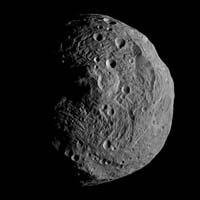 Latest Image of Vesta captured by Dawn on July 17, 2011
Latest Image of Vesta captured by Dawn on July 17, 2011
NASA's Dawn spacecraft obtained this image with its framing camera on July 17, 2011. It was taken from a distance of about 9,500 miles (15,000 kilometers) away from the protoplanet Vesta. Each pixel in the image corresponds to roughly 0.88 miles (1.4 kilometers).
The Dawn mission to Vesta and Ceres is managed by the Jet Propulsion Laboratory, for NASA's Science Mission Directorate, Washington, D.C. It is a project of the Discovery Program managed by NASA's Marshall Space Flight Center, Huntsville, Ala. UCLA, is responsible for overall Dawn mission science. Orbital Sciences Corporation of Dulles, Va., designed and built the Dawn spacecraft.
(Courtesy NASA/JPL-Caltech/UCLA/MPS/DLR/IDA)
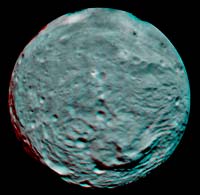 Anaglyph Image of Vesta's South Polar Region
Anaglyph Image of Vesta's South Polar Region
This anaglyph image of the south polar region of the asteroid Vesta was put together from two clear filter images, taken on July 9, 2011 by the framing camera instrument aboard NASA's Dawn spacecraft. Each pixel in this image corresponds to roughly 2.2 miles (3.5 kilometers). The anaglyph image shows the rough topography in the south polar area, the large mountain, impact craters, grooves, and steep scarps in three dimensions. The diameter of Vesta is about 330 miles (530 kilometers). Use red-green (or red-blue) glasses to view in 3-D (left eye: red; right eye: green [or blue]).
(Courtesy NASA/JPL-Caltech/UCLA/MPS/DLR/IDA)
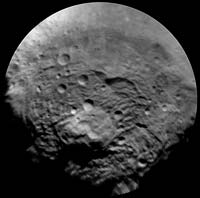 An Enhanced View of Vesta's South Polar Region
An Enhanced View of Vesta's South Polar Region
This image, taken by the framing camera instrument aboard NASA's Dawn spacecraft, shows the south polar region of this object, which has a diameter of 330 miles (530 kilometers). The image was taken through the clear filter on July 9, 2011, as part of a rotation characterization sequence, and it has a scale of about 2.2 miles (3.5 kilometers) per pixel. To enhance details, the resolution was enlarged to .6 miles (1 kilometer) per pixel. This region is characterized by rough topography, a large mountain, impact craters, grooves and steep scarps. The original image was map-projected, centered at 55 degrees southern latitude and 210 degrees eastern longitude.
(Courtesy NASA/JPL-Caltech/UCLA/MPS/DLR/IDA)
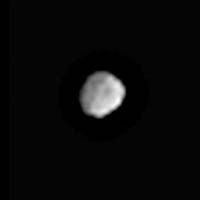 Vesta's Surface Comes into View
Vesta's Surface Comes into View
This movie shows surface details beginning to resolve as NASA's Dawn spacecraft closes in on the giant asteroid Vesta. The framing camera aboard NASA's Dawn spacecraft obtained the images used for this animation on June 1, 2011, from a distance of about 300,000 miles (483,000 kilometers).
Vesta's jagged shape, sculpted by eons of cosmic impacts in the main asteroid belt, is apparent. Variations in surface brightness and hints of surface features can be seen. Vesta's south pole is to the lower right at about the 5 o'clock position.
Vesta is 330 miles (530 kilometers) in diameter and the second most massive object in the asteroid belt. It is also the only large asteroid with a basaltic surface formed due to volcanic processes early in the solar system's history. Vesta is considered a protoplanet because it is a large body that almost formed into a planet.
The video presents 20 frames, looped five times, that span a 30-minute period. During that time, Vesta rotates about 30 degrees. The images included here are used by navigators to fine-tune Dawn's trajectory during its approach to Vesta, with arrival expected on July 16, 2011.
(Courtesy NASA/JPL-Caltech/UCLA/MPS/DLR/IDA)
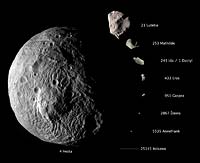 Vesta Sizes Up
Vesta Sizes Up
This composite image shows the comparative sizes of eight asteroids. Up until now, Lutetia, with a diameter of 81 miles (130 kilometers), was the largest asteroid visited by a spacecraft, which occurred during a flyby.
Vesta, which is also considered a protoplanet because it's a large body that almost became a planet, dwarfs all other small bodies in this image, with its diameter sizing up at approximately 330 miles (530 kilometers).
(Courtesy NASA/JPL-Caltech/JAXA/ESA)
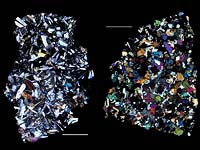 Rocks from Vesta -- Part 1: Eucrites
Rocks from Vesta -- Part 1: Eucrites
The HED (howardite, eucrite and diogenite) meteorites are a large group of meteorites believed to originate from Vesta, a hypothesis that is consistent with current Dawn observations. The eucrites are crystallized lavas that have the composition of basalt, the most common lava type on the Earth. The QUE 97053 (left) and EET 90020 (right) eucrites, pictured here, were recovered in Antarctica. These images are of thin slices of the meteorites as viewed through a polarizing microscope. The white bars in the images, each 2.5 millimeters long, indicate the scale. When polarized light passes through thin slices of rock, different minerals have different colors. QUE97053 (left) consists mostly of elongated gray crystals of feldspar (calcium aluminum silicate) and brightly colored grains of pyroxene (magnesium iron silicate). The texture of this rock is what would be expected from crystallization of a molten magma. EET90020 (right) has similar mineralogy but a recrystallized texture of equant grains formed by later heating. Equant grains have the same or roughly the same dimensions in all directions. Eucrites like these comprise some fraction of Vesta's surface. Their compositions can be compared with observations from various instruments aboard Dawn. They can be compared with the VIR (Visible and Infrared Imaging Spectrometer) spectra to determine mineralogy and with the GRaND (Gamma Ray and Neutron Detector) observations to calibrate and interpret the GRaND instrument's responses.
(Courtesy NASA/JPL-Caltech/Hap McSween (University of Tennessee), and Andrew Beck and Tim McCoy (Smithsonian Institution))
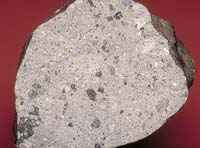 Rocks from Vesta -- Part 2: Howardites
Rocks from Vesta -- Part 2: Howardites
The HED (howardite, eucrite and diogenite) meteorites are a large group of meteorites believed to originate from Vesta, a hypothesis that is consistent with current Dawn observations. Howardites are regolith breccia rocks, meaning that they formed through the grinding and fusion of rock and dust that occurs during meteor impacts on the surface of Vesta. Howardites are comprised of fragments of eucrite and diogenite of varying grain sizes, which can be seen in this picture of the Bununu howardite. This sample weighs 217 grams and was recovered in 1942 in Africa. Along with fragments of eucrite and diogenite, some howardites also contain solar wind implanted noble gasses, which confirms that they once resided on the surface of their parent body. This makes howardites a good laboratory analog for spectral and chemical measurements that will be made of the Vestan surface by Dawn.
(Courtesy NASA/JPL-Caltech/Hap McSween (University of Tennessee), and Andrew Beck and Tim McCoy (Smithsonian Institution))
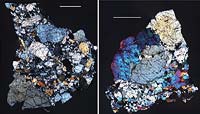 Rocks from Vesta -- Part 3: Diogenites
Rocks from Vesta -- Part 3: Diogenites
The HED (howardite, eucrite and diogenite) meteorites are a large group of meteorites believed to originate from Vesta, a hypothesis that is consistent with current Dawn observations. The diogenites originated deep within the crust of Vesta and resemble rocks, both in texture and composition, which we find in the lower crust of the Earth. The QUE 99050 (left) and GRA 98108 (right) diogenites, pictured here, were recovered in Antarctica. These images are of thin slices of the meteorites as viewed through a polarizing microscope. The white bars in the images, each 2 millimeters long, indicate the scale. When polarized light passes through thin slices of rock, different minerals have different colors. QUE 99050 (left) consists of large gray and yellow crystals of pyroxene (magnesium-iron silicate) and is a subgroup of diogenite called "orthopyroxenitic diogenite" (orthopyroxenite is the name of a rock composed primarily of the mineral orthopyroxene). GRA 98108 (right) has a more mafic (i.e. magnesium and iron rich) mineralogy, consisting of roughly equal portions of pyroxene and the much brighter colored olivine, a silica-poor iron magnesium-iron silicate. This olivine-rich "harzburgitic diogenite" (harzburgite is the name given to a rock composed of a mixture of the minerals orthopyroxene and olivine) is thought to represent the most deep-seated rocks from Vesta that we have in the meteorite collection. Diogenites like these comprise some fraction of Vesta's lower crust, and their compositions can be compared with observations from various instruments aboard Dawn. They can be compared with the VIR (Visible and Infrared Imaging Spectrometer) spectra to determine mineralogy and with the GRaND (Gamma Ray and Neutron Detector) observations to calibrate and interpret the GRaND instrument's responses. Similar rocks have likely been excavated by large impacts, such as the one that formed the Rheasilvia basin at the south pole of Vesta.
(Courtesy NASA/JPL-Caltech/Hap McSween (University of Tennessee), and Andrew Beck and Tim McCoy (Smithsonian Institution))
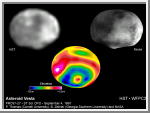 Hubble Reveals Huge Crater on the Surface of the Asteroid Vesta
Hubble Reveals Huge Crater on the Surface of the Asteroid Vesta
This picture shows three views of asteroid Vesta. The one on the left is
a NASA Hubble Space Telescope image, taken in
May 1996 when the asteroid was 110 million miles from Earth. The
asymmetry of the asteroid and "nub" and the south pole is suggestive
that it suffered a large impact event. The image was digitally restored
to yield an effective scale of six miles per pixel.
The picture in the center is a color-encoded elevation map of Vesta which clearly shows the giant 285-mile diameter impact basin and "bull's-eye" central peak. The map was constructed from 78 Wide Field Planetary Camera 2 pictures. Surface topography was estimated by noting irregularities along the limb and at the terminator (day/night boundary) where shadows are enhanced by the low Sun angle.
The picture on the right shows a
3-D computer model of the asteroid Vesta synthesized from Hubble
topographic data. The crater's 8-mile high central peak can clearly be
seen near the pole. The surface texture on the model is artificial, and
is not representative of the true brightness variations on the
asteroid. Elevation features have not been exaggerated.
(Credit: B. Zellner, Georgia Southern University; Peter Thomas, Cornell University;
NASA)
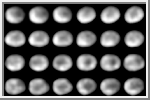 24 Views of Vesta
24 Views of Vesta
This is a NASA Hubble Space Telescope series of 24 images showing the
full 5.34-hour rotation of the 525-kilometer (326-mile) diameter
asteroid Vesta. Hubble resolved features as small as 56 kilometers
(35 miles) across, allowing astronomers to map Vesta's geologically
diverse terrain.
This sequence was taken with Hubble's Wide Field Planetary Camera 2
between November 28 and December 1, 1994, when Vesta was at a distance
of 251 million kilometers (156 million miles)
from Earth.
(Credit: B. Zellner, Georgia Southern University/NASA)

 Asteroids
Asteroids Castalia
Castalia Geographos
Geographos